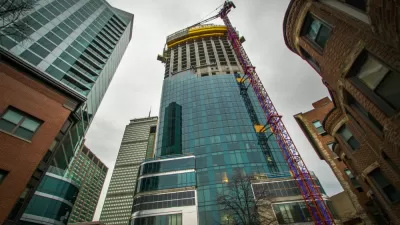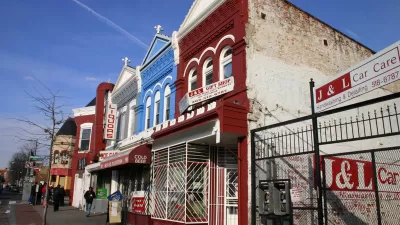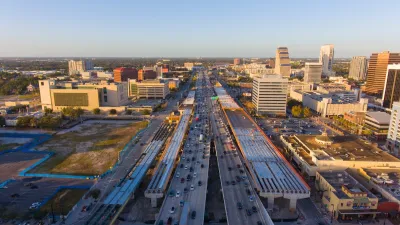Anthony Paletta takes a look at a new book by Elihu Rubin, chronicling the intriguing political history behind the construction of Boston's Prudential Center in the mid-1950s.
The course of urban development in America, Paletta argues, has long been shaped by an overbearing love affair between "the highway engineer and the forward-thinking corporation" – much to the peril of those who use and occupy the city. Elihu Rubin presents a rare case wherein that romance ultimately served to strengthen city spaces in his new book, Insuring the City: The Prudential Center and the Postwar Urban Landscape.
During a period drunk with the symbolic power of the skyscraper, just as the second half of the century was beginning to unfold, Prudential was on the hunt for a site for its New England Regional headquarters. But once Prudential set its sights on Boston's Back Bay rail yard, it fell into contention with the Massachusetts Turnpike Authority, which envisioned an extension of the turnpike running "squarely through the rail yard site." City officials rushed to bring the two visions together, and after a rather painless compromise and a hard-won tax exemption for Prudential, its new signature tower was born.
"The Pru was not by anyone's lights an unqualified triumph," Rubin notes. "As time went on, they were eventually addressed by an extensive reexamination and refurbishment of the project; indeed, these revisions have continued into the 21st century. One indicator of the Pru's success over the long run, however, has been its demonstrated malleability. Designed as an enclave, with its ring road holding back the surrounding city and its podium resting on three layers of parking garages, recent alterations and additions have transformed the Prudential Center from an urban island into what is intended to be a piece of connective urban tissue."
FULL STORY: Bright Solutions from the Dark Age of Urban Planning

Trump Administration Could Effectively End Housing Voucher Program
Federal officials are eyeing major cuts to the Section 8 program that helps millions of low-income households pay rent.

Planetizen Federal Action Tracker
A weekly monitor of how Trump’s orders and actions are impacting planners and planning in America.

The 120 Year Old Tiny Home Villages That Sheltered San Francisco’s Earthquake Refugees
More than a century ago, San Francisco mobilized to house thousands of residents displaced by the 1906 earthquake. Could their strategy offer a model for the present?

HSR Reaches Key Settlement in Northern California City
The state’s high-speed rail authority reached an agreement with Millbrae, a key city on the train’s proposed route to San Francisco.

Washington State Legislature Passes Parking Reform Bill
A bill that would limit parking requirements for new developments is headed to the governor’s desk.

Missouri Law Would Ban Protections for Housing Voucher Users
A state law seeks to overturn source-of-income discrimination bans passed by several Missouri cities.
Urban Design for Planners 1: Software Tools
This six-course series explores essential urban design concepts using open source software and equips planners with the tools they need to participate fully in the urban design process.
Planning for Universal Design
Learn the tools for implementing Universal Design in planning regulations.
Ada County Highway District
Clanton & Associates, Inc.
Jessamine County Fiscal Court
Institute for Housing and Urban Development Studies (IHS)
City of Grandview
Harvard GSD Executive Education
Toledo-Lucas County Plan Commissions
Salt Lake City
NYU Wagner Graduate School of Public Service





























